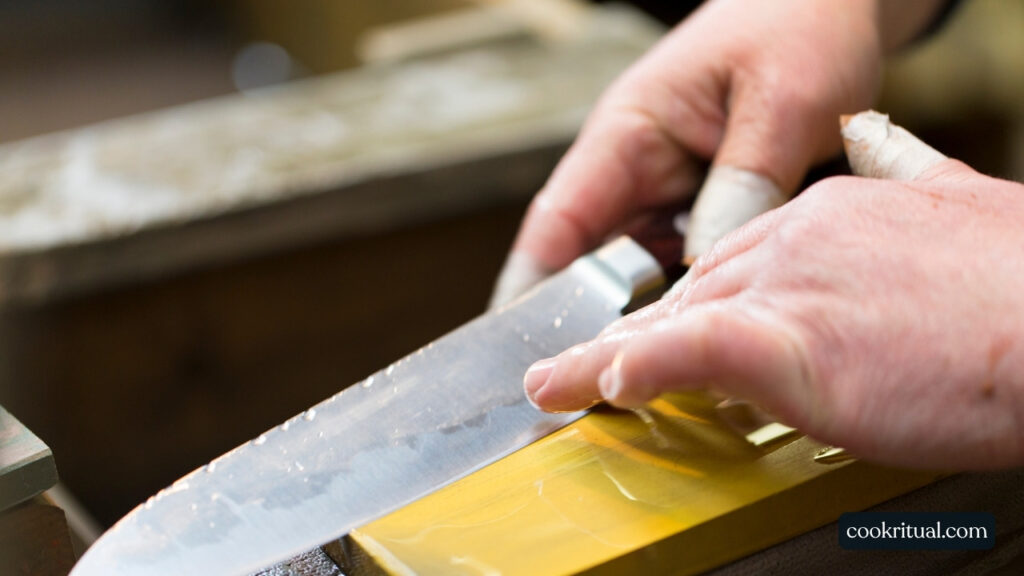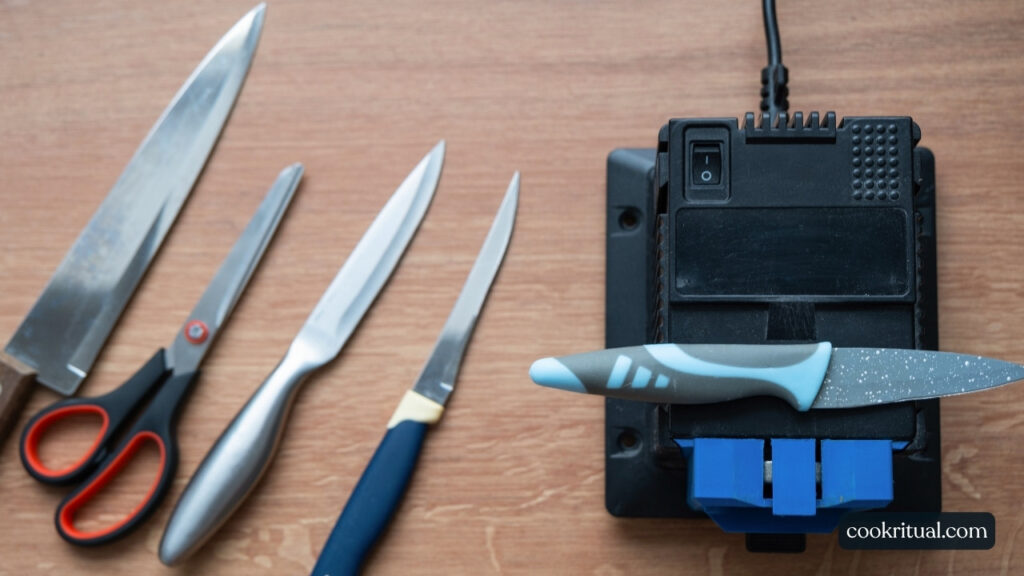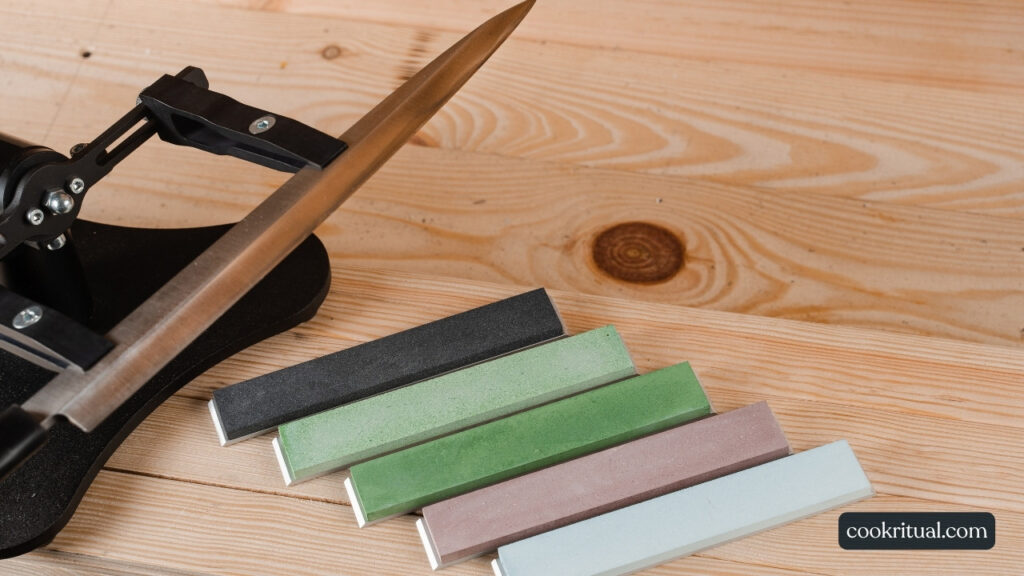Keeping our kitchen knives sharp isn’t just about precision—it’s about safety, efficiency, and elevating our cooking experience at home. A dull knife can crush herbs instead of slicing them cleanly, slip dangerously off vegetables, and turn meal prep into a frustrating chore. For home cooks who want to save time and cook with confidence, learning proper knife sharpening techniques is a game-changer.
In today’s busy world, we don’t always have the luxury of time or access to professional sharpening services. That’s why mastering easy, reliable ways to sharpen knives at home is such a smart investment. Whether we’re preparing a fresh salad, dicing protein for a week of meal prep, or crafting a cozy dinner for the family, a sharp knife makes all the difference.
In this guide, we’ll walk through everything home cooks need to know—from choosing the right tools and understanding sharpening angles to avoiding common mistakes and maintaining long-lasting sharpness. Think of this as your go-to kitchen manual for safe, sharp, and stress-free slicing.
Contents
- 1 1. Why Every Home Cook Needs Sharp Knives
- 2 2. Honing vs Sharpening: What’s the Difference?
- 3 3. Essential Tools for Sharpening Knives at Home
- 4 4. Step-by-Step Knife Sharpening Guide for Beginners
- 5 5. Common Knife Sharpening Mistakes to Avoid
- 6 6. Best Practices for Maintaining Sharp Knives
- 7 7. Manual vs Electric Knife Sharpeners: Which Is Right for You?
- 8 8. Recommended Products and Buying Guide
- 9 9. FAQs About Knife Sharpening for Home Cooks
- 10 Conclusion: Keep Your Kitchen Knives Sharp and Safe
1. Why Every Home Cook Needs Sharp Knives
Better Cooking Starts with a Sharp Knife
A sharp kitchen knife makes slicing, dicing, and chopping faster and safer. When knives are dull, we end up using more pressure, which raises the risk of slipping and cutting ourselves. A clean, sharp blade helps us stay in control with every movement.
Dull Knives Are Dangerous
It might sound strange, but dull knives cause more injuries than sharp ones. According to the American College of Emergency Physicians, a dull blade can slip off food and land on fingers instead. A sharp blade bites into the food surface right away, reducing this risk.
Sharp Knives Save Time and Effort
When our knives glide through tomatoes, herbs, or meats with ease, we save time and energy. It also helps food look better, which is especially helpful if we like to prep meals ahead or serve guests.
2. Honing vs Sharpening: What’s the Difference?
Honing Helps Maintain the Edge
Honing is not the same as sharpening. When we use a honing rod, we’re not cutting new metal—we’re simply realigning the edge of the blade. Over time, knife edges bend slightly with use. Honing resets that edge and keeps the blade straight.
We recommend using a honing rod once or twice a week if we cook often. For a clear demo, check out this guide by Serious Eats.
Sharpening Actually Removes Metal
Sharpening, on the other hand, means grinding down the blade to form a new, sharp edge. This is often done with a whetstone, sharpening steel, or electric sharpener. It’s more intense than honing and should be done less frequently—maybe once a month, depending on how often we cook.
Use Both for Best Results
Honing keeps knives sharp longer, while sharpening brings dull knives back to life. Using both together gives us the best of both worlds: daily readiness and long-term performance.
3. Essential Tools for Sharpening Knives at Home
Whetstones: The Classic Choice
A whetstone (also called a water stone) is a flat stone used to manually sharpen knives. It may take a bit of practice, but it gives us precise control over the sharpening angle. Whetstones often come in two grits—one coarse side to sharpen, and one fine side to polish.
We suggest starting with a 1000/6000 grit combo stone. For quality options, check reviews from trusted sources like America’s Test Kitchen.
Electric Knife Sharpeners: Quick and Easy
If we’re short on time, electric knife sharpeners offer a fast fix. These machines pull the blade through preset angles, sharpening both sides quickly. While they may not give pro-level results, they’re perfect for home cooks who want low-effort results.
Check ratings on reliable product sites like Consumer Reports.
Honing Rods: Daily Maintenance Made Easy
A ceramic or steel honing rod is perfect for keeping edges aligned between sharpening sessions. It takes just a few seconds to use and helps extend the time between full sharpenings.
Look for rods around 10–12 inches in length with a non-slip handle for safety.
Optional Tools That Help
- Angle guides to keep the blade at the right sharpening angle
- Cut-resistant gloves for safe sharpening
- Sharpening oil or water (depending on the stone type)
4. Step-by-Step Knife Sharpening Guide for Beginners
How to Sharpen with a Whetstone

Using a whetstone may feel tricky at first, but it’s simple once we get the hang of it. Here’s how to do it:
- Soak the stone in water for about 10–15 minutes (unless it’s an oil stone).
- Place it on a non-slip surface, like a damp towel or stone holder.
- Hold the knife at a 15° to 20° angle, depending on the blade type.
- Slide the blade across the coarse side, edge first, using even strokes.
- Repeat on the other side of the blade, keeping the same angle.
- Flip the stone and use the fine side to polish the edge.
- Rinse the blade and wipe it dry before storing.
For a helpful video demo, we can check this sharpening tutorial by Knife Informer.
How to Use an Electric Knife Sharpener Safely
Electric knife sharpeners make the job easy:
- Plug in the machine and choose the right slot (coarse or fine).
- Insert the knife and draw it through slowly, from heel to tip.
- Repeat 2–3 times per side, depending on how dull the blade is.
- Finish with the fine slot for a polished edge.
Brands like Chef’sChoice are well-rated and known for safe, home-friendly designs. For trusted product picks, see Wirecutter’s top knife sharpeners.
Mastering the Right Sharpening Angle
Most kitchen knives sharpen best at 15° to 20° angles. Japanese knives often use 15°, while Western knives are closer to 20°. A consistent angle is key for even sharpening.
To help with angle accuracy, beginners can use an angle guide clip or reference visual aids from Work Sharp Tools.
Finish with a Honing Rod
After sharpening, we should always hone the blade to align the edge. Just 4–5 strokes per side is enough to make it slicing-ready again.
5. Common Knife Sharpening Mistakes to Avoid
Over-Sharpening Can Ruin the Blade
Sharpening too often can remove too much metal from the blade. This shortens the life of our knives. If the knife still slices cleanly, it likely doesn’t need sharpening yet—just a quick honing.
Wrong Angle = Poor Results
Sharpening at the wrong angle leads to a dull or uneven edge. A too-steep angle removes more metal than needed, while too shallow doesn’t cut at all. For tips, see this angle guide from Cook’s Illustrated.
Skipping the Cleaning Step
After sharpening, we must always clean the blade. Tiny bits of metal and grit can stick to it, making food prep unsafe. Use warm, soapy water and a soft cloth to clean and dry the knife before using it again.
6. Best Practices for Maintaining Sharp Knives
How Often Should You Sharpen Kitchen Knives?
It depends on how often we cook. On average:
- Hone the knife after every 2–3 uses
- Sharpen the knife once a month or every few months
- Test the blade by slicing a tomato or paper—if it tears, it’s time to sharpen
For more on blade care frequency, check out this USDA food safety guide.
Smart Storage for Sharp Knives
Proper storage helps maintain the edge. Try these options:
- Knife blocks or magnetic strips
- Blade guards for drawer storage
- Avoid tossing knives in a drawer with other utensils
What to Do After Sharpening
After sharpening or honing:
- Wipe down the blade
- Store it properly
- Keep it dry to prevent rust
- Use a soft cutting board (like wood or plastic—not glass)
By following these steps, we keep our knives sharp, safe, and long-lasting.
7. Manual vs Electric Knife Sharpeners: Which Is Right for You?

Manual Sharpeners Offer More Control
Manual knife sharpeners—like whetstones and pull-through models—give us more control over the sharpening angle and pressure. They’re perfect for people who enjoy hands-on work and want professional-level sharpness.
Manual sharpeners also remove less metal, helping knives last longer. While they take more time and skill, they’re great for high-quality knives. For sharpening stone reviews, check out this Buyer’s Guide from Serious Eats.
Electric Sharpeners Are Fast and Convenient
If we want speed and simplicity, electric knife sharpeners are ideal. They use motorized slots to guide the blade and sharpen evenly. These tools are beginner-friendly, making them perfect for busy home cooks.
However, they may remove more metal and might not work well for delicate or specialty knives. For detailed comparisons, check the Consumer Reports knife sharpener guide.
Which Should You Choose?
Choose manual sharpeners if:
- You have premium knives
- You want more sharpening control
- You’re comfortable learning a technique
Choose electric sharpeners if:
- You need quick results
- You cook daily and want a low-effort option
- You’re new to sharpening
8. Recommended Products and Buying Guide
Top Whetstones for Home Use

For beginners, we suggest a combo whetstone with 1000/6000 grit. It offers both sharpening and polishing. Look for stones with a non-slip base and clear instructions. Trusted options include:
- Sharp Pebble Premium Whetstone – beginner-friendly with angle guide
- Naniwa Professional Stone – higher-end, used by chefs
Check reviews and safety tips on America’s Test Kitchen.
Best Electric Knife Sharpeners
Some reliable models include:
- Chef’sChoice 15 Trizor XV – sharpens to a 15° angle for fine edges
- Work Sharp Culinary E5 – user-friendly with built-in guides
Browse electric sharpeners tested by Wirecutter.
Helpful Accessories
- Honing rods: ceramic or steel, for regular maintenance
- Cut-resistant gloves: to stay safe while sharpening
- Blade angle guides: ideal for beginners learning angles
Buying good tools now means fewer headaches later—and better meals every time.
9. FAQs About Knife Sharpening for Home Cooks
How Often Should You Sharpen Knives?
Most home cooks should sharpen knives every 1–3 months, depending on use. If it struggles to slice a tomato, it’s time.
Can You Over-Sharpen a Knife?
Yes. Too much sharpening removes metal and wears the blade down. Only sharpen when needed, and hone often.
Do All Kitchen Knives Use the Same Angle?
No. Japanese knives usually use 15° angles, while Western knives use 20°. Check your knife type first. Learn more from this angle guide by Knife Depot.
Is a Sharpening Steel the Same as a Honing Rod?
Yes. Honing rods (also called steels) realign the edge but don’t sharpen. Use them between sharpenings.
What Cutting Boards Protect Knife Edges?
Use soft surfaces like wood or plastic. Avoid glass, stone, or metal—they dull knives fast. For knife-safe boards, check this guide from Epicurious.
Conclusion: Keep Your Kitchen Knives Sharp and Safe
Sharpening kitchen knives doesn’t have to be hard or expensive. With the right tools and a little know-how, we can keep our blades in top shape—and cook better meals every day.
Whether we choose a manual whetstone for precision or an electric sharpener for speed, what matters most is consistency.


